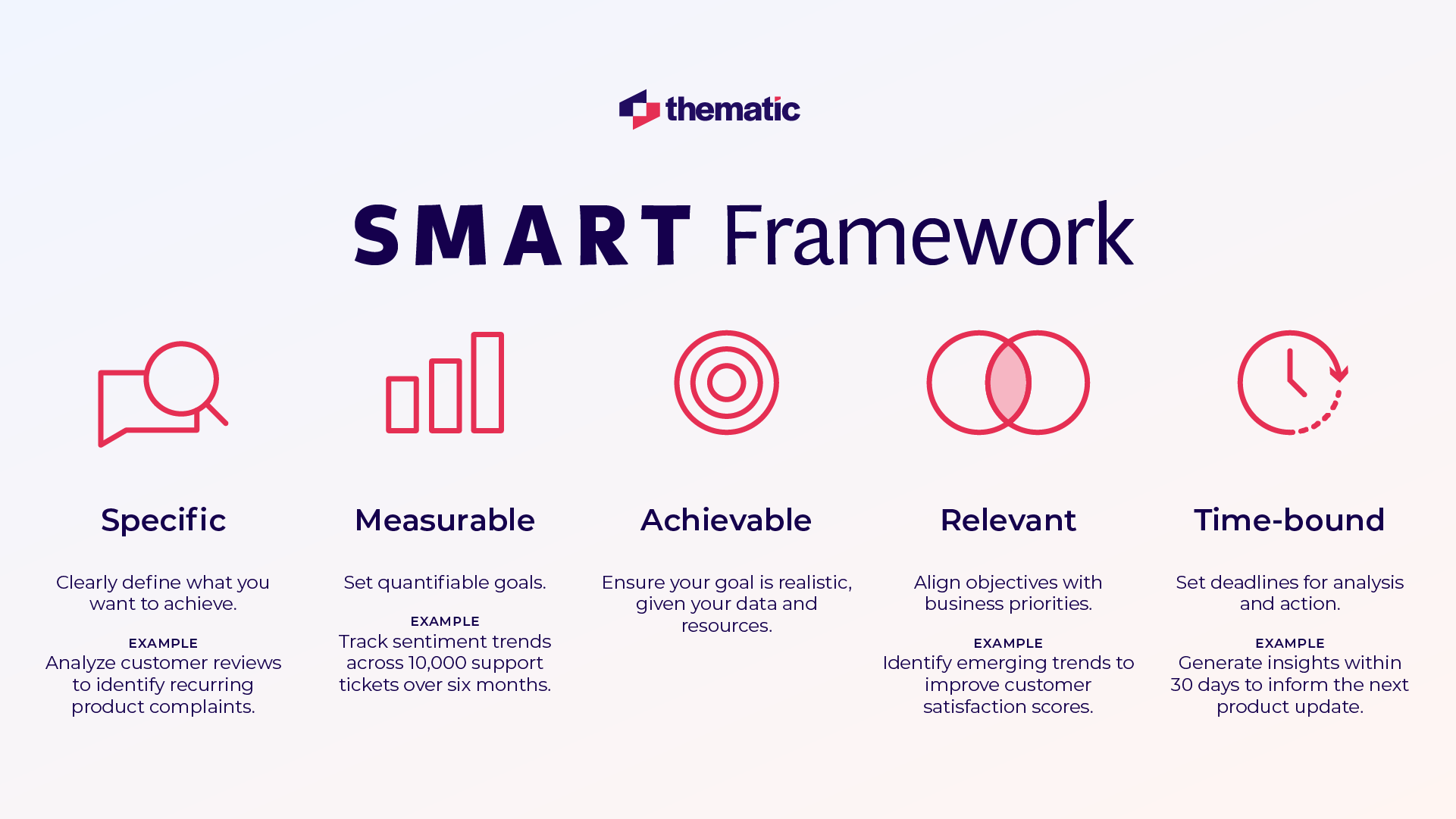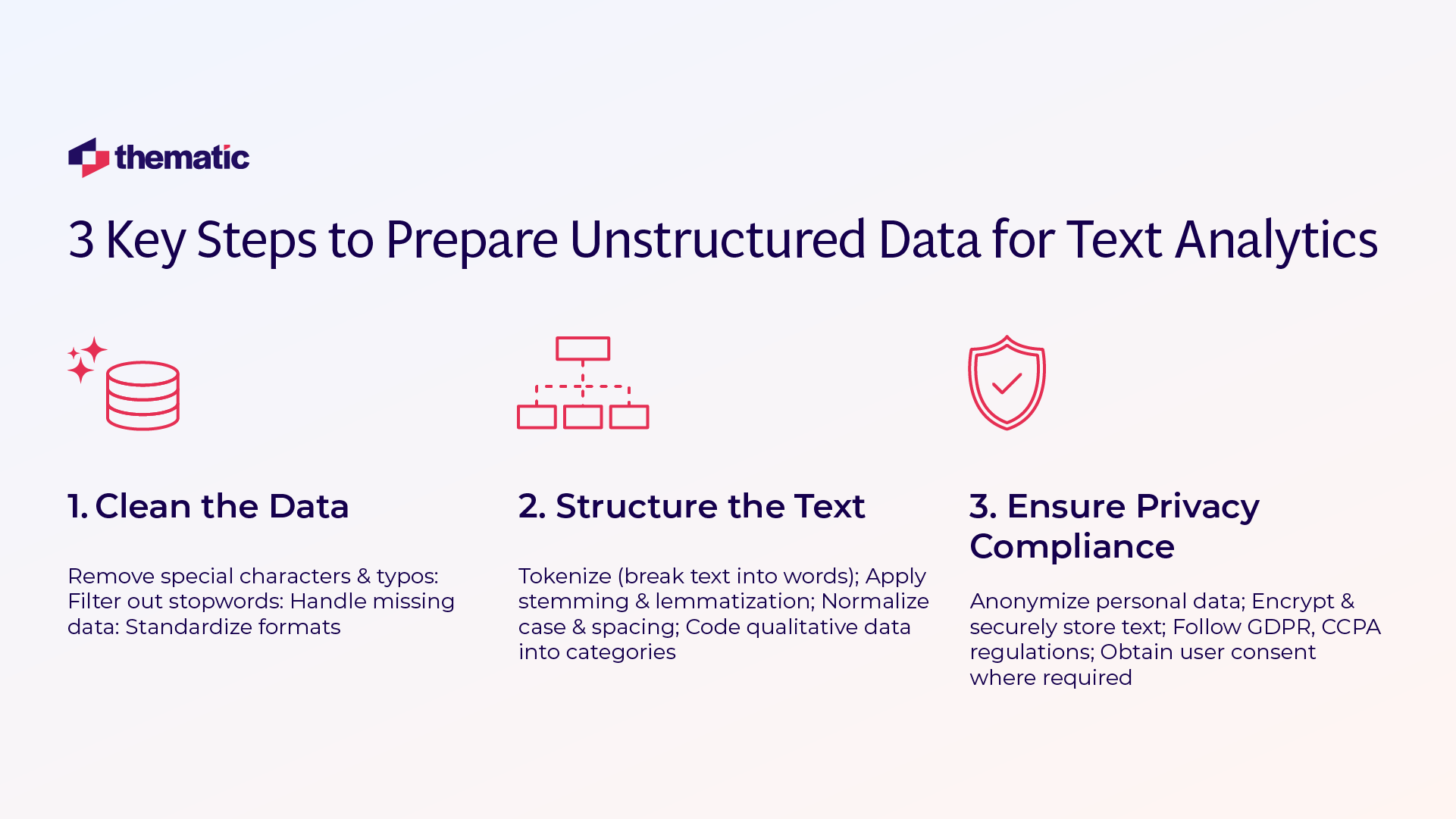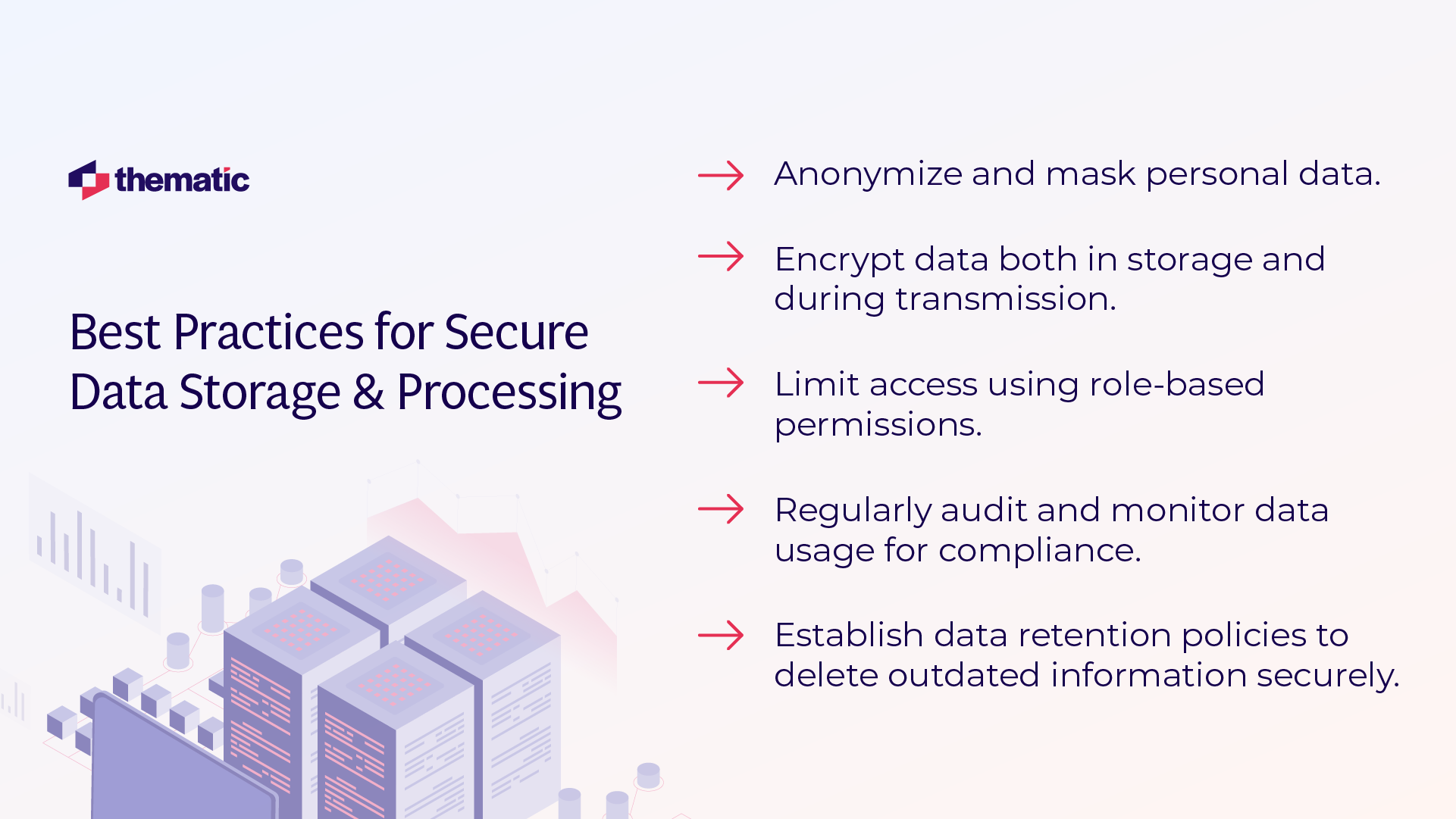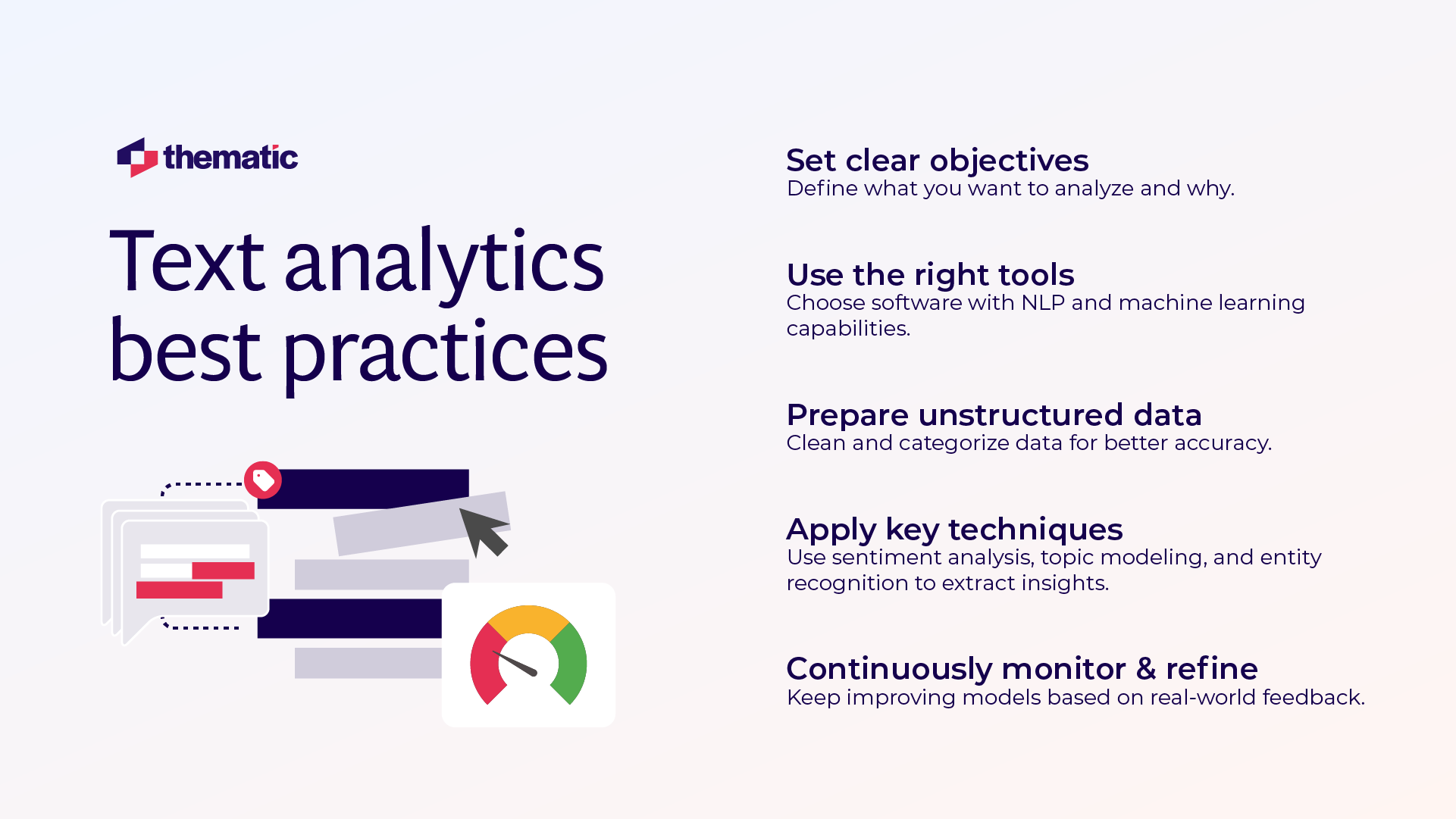
Explore best practices for getting started with text analytics, from setting goals to leveraging NLP and AI techniques.

Did you know? In 2024, the world generated 149 zettabytes, and that’s expected to reach 394 zettabytes by 2028. That’s equivalent to every person on Earth streaming 4K video nonstop for over three years or stacking enough books to reach the moon and back…100 times.
But that data means nothing if not properly analyzed. Businesses need text analytics done right to extract valuable insights that they can use for effective decision-making.
There are text analytics best practices to keep in mind:
In this guide, we break down these text analytics best practices to help you turn raw text into actionable intelligence.
Before diving into text analytics, it’s essential to define clear objectives. Without a focused goal, businesses risk drowning in data without extracting meaningful insights.
One of the top challenges in text analytics is dealing with unstructured text. Without a well-defined plan, businesses may extract data that is too broad, irrelevant, or difficult to interpret, leading to inaccurate insights.
The book Artificial Intelligence and Evaluation highlights the importance of structured planning:
"As expected, well-defined categories and subcategories in the taxonomy (such as legal obstacles, political risk, and market pricing) tend to generate fewer false positives than broader ones. In contrast, where categories were imprecisely specified a priori, the model faced greater difficulties in converging on the correct categories and had to be further refined following an iterative process."
When goals are too vague—such as “analyze customer feedback” without specifying which aspects to focus on (e.g., pricing concerns, product quality, or customer service)—the results become inconsistent and require multiple refinements.
However, when businesses set specific objectives and categorize data properly, models can classify text more accurately, leading to actionable insights with fewer errors.
So, how do you create objectives? To ensure success, apply the SMART framework when defining your text analytics objectives:
Setting objectives is a given in any business endeavor, but it helps to be reminded of this first in the list of text analytics best practices. Be smart, and make SMART objectives.

With the vast amount of text data available today, selecting the right text analytics tool is crucial for extracting meaningful insights. The right platform can help businesses understand customer sentiment, monitor trends, and optimize decision-making.
However, not all tools are created equal—some offer basic text processing, while others use advanced AI-powered natural language processing (NLP) or large language models (LLMs) to uncover deeper insights.
When evaluating text analytics platforms, consider these essential features:
In the history of text analytics, you will see that traditional text analysis relies on rule-based keyword searches, which can be rigid and miss context. For example, a simple keyword-based tool may flag "great service" as positive but fail to detect sarcasm in "Oh, great service…".
In contrast, AI-powered NLP solutions can:
Meanwhile, many modern tools, like Thematic, now incorporate large language models (LLMs) and generative AI to further enhance qualitative data analysis. These advanced models bring several advantages:
By leveraging AI-powered text analysis tools with LLM capabilities, businesses can gain deeper, more accurate insights from text analytics while reducing the need for manual intervention.
To choose the right text analytics platform, businesses should:
With the right text analytics tool, businesses can automate data analysis, improve decision-making, and uncover valuable insights in real time.
Before text analytics can generate valuable insights, raw text data must be cleaned, structured, and formatted for analysis. Since most business data arrives in an unstructured format, proper data preparation ensures accuracy and reliability.
Unstructured data often contains irrelevant characters, typos, or incomplete sentences that can mislead analytical models. Data cleaning involves:
By ensuring clean input, businesses improve data accuracy and model performance.
Once the data is clean, it needs to be converted into a structured format for meaningful analysis. This process involves:
By structuring data properly, text analytics tools can recognize patterns, categorize responses, and extract meaningful insights more effectively.
Handling sensitive customer data comes with legal responsibilities. Organizations must comply with data privacy regulations such as:
To stay compliant:
Among the text analytics best practices, data cleaning is one that must not be missed because it sets the groundwork. Remember, when the foundation is faulty, the structure might fall apart.

Once data is cleaned and structured, the next step is to apply text analytics techniques to extract meaningful insights. Businesses use these methods to understand customer sentiment, uncover trends, and improve decision-making.
We’ll talk about three techniques, that when combined, can:
✅ Improve customer support by identifying common complaints
✅ Enhance products & services based on real user feedback
✅ Make data-driven decisions to stay ahead of market trends
Sentiment analysis helps businesses determine whether text expresses positive, negative, or neutral emotions. This is especially useful for tracking customer feedback, online reviews, and net promoter score (NPS) surveys.
Example: A company analyzing support tickets might find that words like "slow response" or "frustrating experience" correlate with lower NPS scores, signaling a need for service improvements.
How it helps:
✅ Measures customer satisfaction at scale
✅ Identifies pain points and areas for improvement
✅ Helps brands track public perception over time
Topic modeling groups similar words and phrases to reveal hidden patterns in text data. Instead of manually sorting through thousands of reviews, businesses can use this technique to detect recurring topics in customer feedback.
Example: An e-commerce brand may find that "shipping delay" and "damaged packaging" frequently appear together, highlighting an issue in logistics.
How it helps:
✅ Automatically discovers emerging trends
✅ Prioritizes areas that need attention
✅ Saves time by summarizing large datasets
Entity recognition identifies important names, locations, brands, and product mentions in text. This technique is widely used for social media monitoring, competitor analysis, and brand tracking.
Example: A hotel chain analyzing customer reviews can extract mentions of specific locations (e.g., "New York branch") to assess performance across different regions.
How it helps:
✅ Tracks brand reputation across platforms
✅ Identifies competitor mentions
✅ Helps businesses personalize marketing strategies
As businesses collect and analyze vast amounts of text data, data security and compliance must be a top priority. Mishandling sensitive information can lead to legal penalties, reputational damage, and loss of customer trust.
By prioritizing data security and compliance, businesses can:
A secure approach to text analytics helps organizations extract insights without compromising privacy, ensuring compliance while maximizing business value.
Text analytics often involves customer feedback, support tickets, emails, and social media interactions—which may contain personal or sensitive information. The biggest privacy risks include:
To protect customer data while using text analytics, businesses should:
Different regions have strict data privacy laws that businesses must comply with:

Text analytics models are not set-and-forget solutions. Over time, language evolves, customer expectations shift, and data patterns change, which can cause machine learning models to degrade in accuracy.
As a closing to our list of text analytics best practices, remember to continuously monitor, refine, and update their models.
Text analytics models rely on patterns in language, but these patterns can shift due to:
For example, a customer satisfaction model trained a year ago may struggle to interpret new product names, emerging issues, or shifts in sentiment expression. Without regular updates, insights become outdated, leading to poor decision-making.
Even with advanced AI, human oversight remains essential. Businesses should:
For instance, if customers start using “mid” as a negative review term, human feedback ensures that the model adapts to new expressions of dissatisfaction.
Thematic’s approach allows analysts to edit and refine AI-generated themes, ensuring insights are both accurate and actionable. This human-in-the-loop system provides the best of both worlds: AI efficiency with expert-driven accuracy, leading to better decision-making and improved customer insights.
To keep text analytics models performing well, companies should:
Implementing continuous monitoring and improvement helps businesses ensure text analytics remains accurate, responsive, and aligned with evolving customer needs.
Successful companies don’t just collect customer feedback—they apply text analytics best practices to transform raw data into meaningful action. The case studies below illustrate how top businesses implemented key text analytics strategies to drive customer satisfaction and business growth.
Best Practices Applied:
Results:
By following best practices, Atom Bank transformed scattered, unstructured data into focused insights, leading to higher efficiency and customer satisfaction.
Best Practices Applied:
Results:
By consistently monitoring feedback and refining their approach, DoorDash increased driver engagement and improved retention.
Best Practices Applied:
Results:
By integrating structured text analytics across multiple feedback sources, Instacart improved its platform, leading to better usability and overall satisfaction.
These businesses applied text analytics best practices and succeeded in their text analytics journey.

Text analytics is a powerful tool for uncovering customer insights, improving operations, and driving business growth. By following text analytics best practices, companies can set clear objectives, choose the right tools, clean and structure data, apply key techniques like sentiment analysis, and continuously refine their models.
These steps ensure that businesses extract actionable, high-impact insights from unstructured text data.
Ready to see the impact of text analytics on your business? Try Thematic on your own data and unlock deep customer insights with AI-powered analytics. Turn feedback into action and drive measurable results today!
Text analytics can process various types of unstructured data, including customer reviews, survey responses, social media comments, emails, support tickets, chat transcripts, and news articles. The key is to ensure that data is properly cleaned and structured before analysis for accurate insights.
Success in text analytics is measured using key performance indicators (KPIs) such as:
Yes! Many modern text analytics platforms support multilingual processing, using NLP and machine translation to analyze text across different languages. However, accuracy may vary based on the language complexity, availability of training data, and linguistic nuances (e.g., idioms and cultural context).
Some of the most common pitfalls include:
Join the newsletter to receive the latest updates in your inbox.